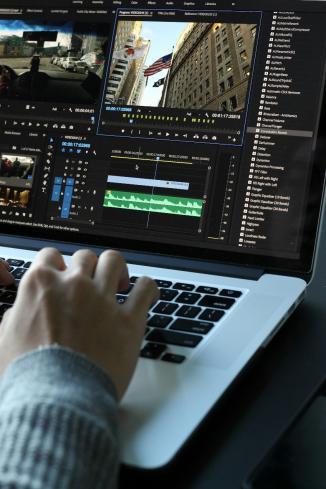The Science Behind Audio Enhancement: Bringing Unclear Recordings to Light

In today's digital age, audio enhancement has become a critical tool for various fields, including law enforcement, journalism, and even personal use. Whether it's clarifying a crucial piece of evidence in a court case, enhancing a muffled interview recording, or simply improving the sound quality of a cherished home video, the science behind audio enhancement is both fascinating and essential.
This blog aims to demystify the process of audio enhancements, making it accessible and engaging for anyone interested in understanding how unclear recordings can be brought to light.
Understanding Audio Enhancement
Audio enhancement involves a series of processes designed to improve the clarity and quality of audio recordings. The goal is to make the speech or sound within a recording more intelligible while minimizing background noise and distortions. This process relies on a combination of hardware and software tools, as well as a deep understanding of sound engineering principles.
The Basics of Sound and Audio Quality
To appreciate the science behind audio enhancement, it's essential to understand the basics of sound and noise. Sound is a mechanical wave that travels through a medium, typically air, and is perceived by our ears. Noise, on the other hand, is any unwanted sound that interferes with the intended audio signal. In audio recordings, noise can come from various sources, including environmental sounds, electronic interference, and recording equipment limitations. Sound’s quality is determined by several factors:
· Frequency: Measured in Hertz (Hz), frequency determines the pitch of the sound. Humans can hear frequencies between 20 Hz and 20,000 Hz.
· Amplitude: This determines the loudness of the sound. Higher amplitudes mean louder sounds.
· Waveform: The shape of the sound wave affects the tone and quality of the sound.
· Bit Depth: In digital audio, bit depth determines the resolution of the sound. Higher bit depths provide better sound quality.
Common Issues in Audio Recordings
Unclear recordings can result from various issues, including:
· Background Noise: Unwanted sounds can interfere with the clarity of the main audio.
· Distortion: Excessive amplitude can cause the audio to distort, making it difficult to understand.
· Echo and Reverberation: Reflections of sound can create echoes and reverberations, complicating the clarity of the recording.
· Low Bit Rate: In digital audio, a low bit rate can reduce sound quality, making it harder to discern details.
Key Concepts in Audio Enhancement
Several key concepts are fundamental to the process of audio enhancement:
1. Signal-to-Noise Ratio (SNR): This is a measure of the desired signal strength relative to the background noise level. A higher SNR indicates a clearer recording, while a lower SNR signifies more noise.
2. Frequency: Sound is composed of various frequencies, which determine the pitch of the sound. Enhancing audio often involves manipulating these frequencies to highlight the desired sounds and reduce unwanted noise.
3. Amplitude: This refers to the loudness of the sound. Audio enhancement can involve adjusting the amplitude to ensure that the important parts of the recording are audible.
The Audio Enhancement Process
Step 1: Noise Reduction
The first step in audio enhancement is often noise reduction. This involves identifying and minimizing background noise to make the primary audio signal clearer. There are several techniques for noise reduction:
1. Spectral Subtraction: This method involves analyzing the frequency spectrum of the audio and subtracting the noise profile from the signal. It is effective for reducing consistent background noises like hums or hisses.
2. Adaptive Filtering: Adaptive filters adjust their parameters in real time to minimize noise based on the characteristics of the audio signal. This technique is particularly useful for recordings with varying noise levels.
3. Noise Gate: A noise gate allows audio signals above a certain threshold to pass through while attenuating signals below that threshold. This can help eliminate background noise during quieter moments in the recording.
Step 2: Equalization
Equalization (EQ) involves adjusting the balance between different frequency components of the audio signal. This step is crucial for enhancing the clarity of speech and other important sounds. EQ can be used to:
1. Boost Desired Frequencies: By amplifying certain frequency ranges, such as the frequencies associated with human speech, the clarity of the audio can be improved.
2. Cut Unwanted Frequencies: Reducing the amplitude of frequencies that contribute to noise or distortion helps to clean up the recording.
Step 3: Compression
Compression is a technique used to control the dynamic range of an audio signal. The dynamic range is the difference between the loudest and quietest parts of the recording. Compression helps to:
1. Even Out Volume Levels: By reducing the volume of loud sounds and boosting the volume of quieter sounds, compression ensures a more consistent listening experience.
2. Enhance Speech Intelligibility: Compression can make speech more intelligible by ensuring that quieter speech parts are audible.
Step 4: Restoration
Restoration techniques aim to repair and improve audio recordings that have been damaged or degraded over time. Common restoration techniques include:
1. De-clicking and De-crackling: These methods remove clicks, pops, and crackles often found in old vinyl records or degraded digital recordings.
2. De-essing: De-essing reduces excessive sibilance (harsh "s" sounds) in speech recordings, which can be distracting and reduce clarity.
3. De-noising: This involves removing broadband noise, such as tape hiss or environmental noise, from the recording.
Step 5: Enhancement
The final step in the audio enhancement process is enhancement, where the overall quality of the audio is improved. This can involve:
1. Reverb and Ambience: Adding subtle reverb or ambience can make the audio sound more natural and less dry.
2. Stereo Imaging: Enhancing the stereo image can create a more immersive listening experience by widening the soundstage.
3. Mastering: The mastering process involves fine-tuning the audio to ensure it meets professional standards and sounds as good as possible across different playback systems.
The Importance of Audio Enhancement
Audio enhancement is the process of improving the quality and clarity of audio recordings. This process is essential in several scenarios:
1. Law Enforcement: Clear audio can provide critical evidence in criminal investigations. Enhanced recordings can help identify suspects, understand conversations, and verify alibis.
2. Journalism: In investigative journalism, clear audio can reveal hidden truths and support investigative stories.
3. Entertainment: High-quality audio is crucial for media content. Whether it's a podcast, film, or music recording, clear and crisp audio enhances the listener's experience.
Advanced Audio Enhancement Technologies
Modern audio enhancement leverages advanced technologies, including machine learning and artificial intelligence (AI), to improve the clarity and quality of recordings.
Machine Learning and AI
Machine learning and AI algorithms can analyze large amounts of audio data to identify patterns and improve audio quality:
· Noise Profiles: AI can learn to recognize and differentiate between noise and desired audio, making noise reduction more effective.
· Automatic EQ and Compression: Machine learning algorithms can automatically adjust EQ and compression settings based on the characteristics of the audio.
· Speech Enhancement: AI-powered speech enhancement tools can isolate and enhance speech in recordings, making conversations clearer and more understandable.
Software and Tools
There are numerous software tools available for audio enhancement. Some of the most popular include:
· Adobe Audition: A professional audio editing software with advanced noise reduction, EQ, and compression tools.
· iZotope RX: A specialized audio restoration software with powerful de-noising, de-clicking, and de-reverberation capabilities.
· Audacity: A free, open-source audio editor with basic noise reduction and EQ tools.
Applications of Audio Enhancement
Law Enforcement and Forensics
One of the most critical applications of audio enhancement is in law enforcement and forensic investigations. Enhanced audio recordings can provide crucial evidence in criminal cases, helping to clarify speech and identify suspects. Techniques such as noise reduction, EQ, and compression are often used to make unclear recordings more intelligible.
Journalism and Media
Journalists and media professionals frequently rely on audio enhancement to improve the quality of interviews, field recordings, and broadcasts. Clear audio is essential for delivering accurate and engaging stories. Enhancing audio ensures that important voices and sounds are heard clearly, even in noisy environments.
Personal Use
Audio enhancement is also valuable for personal use. Whether it's improving the sound quality of home videos, voice memos, or old recordings, enhanced audio can preserve cherished memories and make everyday recordings more enjoyable.
Entertainment Industry
In the entertainment industry, audio enhancement plays a crucial role in music production, film, and television. Enhancing dialogue, sound effects, and musical elements ensures a high-quality listening experience for audiences.
Case studies: Real-World Experiences with Audio Enhancement
Case Study 1: Forensic Investigation
In a recent high-profile case, law enforcement officers used audio enhancement to identify an important piece of evidence. The original recording was muffled and filled with background noise, making it difficult to understand. By applying noise reduction, EQ, and compression techniques, audio forensics expert were able to isolate and enhance the suspect's voice, providing clear evidence that contributed to a successful conviction.
Case Study 2: Journalistic Excellence
A journalist covering a breaking news story faced the challenge of recording an interview in a noisy public space. The initial recording was filled with ambient noise, making it hard to hear the interviewee. Using audio enhancement techniques, the journalist was able to reduce the background noise and boost the interviewee's voice, resulting in a clear and impactful news segment.
Case Study 3: Personal Memories Preserved
A family discovered an old cassette tape containing a recording of their grandparents' voices. The tape was degraded, with significant hiss and crackling. By using restoration techniques such as de-clicking, de-noising, and EQ, they were able to enhance the audio quality and preserve precious memories for future generations.
Testimonials: The Impact of Audio Enhancement
To illustrate the impact of audio enhancement, here are a few testimonials from individuals who have experienced the benefits of enhanced audio recordings:
Law Enforcement Officer
"As a detective, clear audio is crucial for solving cases. Enhanced recordings have helped us identify suspects, understand conversations, and build strong evidence for prosecution. Audio enhancement tools have made a significant difference in our investigations."
Investigative Journalist
"Audio enhancement has been a game-changer for my investigative work. Clear audio recordings have allowed me to uncover hidden truths and support my stories with accurate information. The ability to enhance covert recordings and interviews has been invaluable."
Music Producer
"In the studio, high-quality audio is essential. Audio enhancement tools have helped me produce clear and balanced recordings, removing unwanted noise and ensuring that every detail is heard. These tools have elevated the quality of my music production."
Staying Updated with the Latest Audio Enhancement Techniques
As technology continues to advance, staying updated with the latest audio enhancement techniques is crucial for professionals in the field. Here are some ways to keep abreast of the latest developments:
1. Continuous Education: Enroll in courses and training programs that focus on audio engineering and enhancement techniques. Many institutions and online platforms offer specialized courses in this area.
2. Professional Organizations: Join professional organizations such as the Audio Engineering Society (AES) to access resources, attend conferences, and network with other professionals.
3. Industry Publications: Subscribe to industry publications and journals to stay informed about the latest research, techniques, and tools in audio enhancement.
4. Hands-On Experience: Regularly practice and experiment with new tools and techniques. Setting up a test lab can help you stay proficient and adapt to new technologies.
Conclusion
The science behind audio enhancement is a blend of art and technology, requiring a deep understanding of sound principles and proficiency with advanced tools and techniques. From reducing noise to restoring old recordings, audio enhancement plays a vital role in various fields, including law enforcement, journalism, entertainment, and personal use.
By staying updated with the latest developments and continuously refining their skills, audio professionals can ensure they are equipped to bring unclear recordings to light, providing clarity and enhancing the listening experience for all.
Are you ready to enhance your audio recordings and uncover hidden details? We over at Eclipse Forensics have got you covered.
Contact our team of audio forensic expert today to learn more about our professional audio enhancement services and how we can help you.















Comments